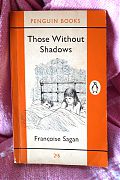
Françoise Sagan
Those Without Shadows
If I were allowed two words to describe this book, they would be short and French. I read it on a recommendation by a French friend of mine, who pointed me to anything by Françoise Sagan; Françoise Sagan is also French. Those Without Shadows was the first of Sagan’s books I happened across (on the wonderful Bookmooch). Apparently Sagan is making a come back in France and even in Italy, as I saw her books propped up in French and Italian in the Feltrinelli on Largo Argentina. But as for me, I had never heard her name before.
Sagan made her debut when at eighteen she dropped out of the Sorbonne after failing her examinations and began to write a novel instead: Bonjour Tristesse was a huge success. The bio on my edition reads: Her hobby is driving fast cars, of which she has five, and in 1957 she was involved in a bad road accident. Between 1954 and 1996 she wrote twenty novels. Those Without Shadows or Dan un Mois, Dans un An, from a line in Phèdre, was her third book and published in 1957.
Those Without Shadows oscillates around a group of mostly young Parisians who oscillate between love affairs with each other. Sagan’s prose illustrates the almost seamless nature by which they go into each other’s arms, as characters flow back and forth and into another with sheer naturalness. In the same way their personalities meld together to illustrate a similar despondency and emptiness, an almost pointlessness to their love affairs and greater, their lives.
They sat on a bench in the rain, which never ceased. They were dead tired. She told him she did not love him and he replied that it did not matter, and the poverty of their words brought tears to their eyes.
The only one with any drive is Béatrice. She wants to be an actress, to embody a character, a fictional role, on a stage. Even when she succeeds she thinks:
Success was like a victory, something had been won, and she was surprised that the effects should so soon have vanished.
As I read I couldn’t relate to these characters who lives are so pointless to themselves. But I was never frustrated and now that I am finished and flipping through the yellowing pages, I realize how much Françoise Sagan managed to pack into the thin book. Each character has a longing within the moth-eaten fabric of their lives, seeking happiness and love, but not believing happiness or love exist.
The damp cigarette that Bernard tried unsuccessfully to light was symbolic of their lives, for they would never know real happiness and were aware of it, but they also felt that it was not at all important.
· · · · · · · · · · · · · · · · · · · ·